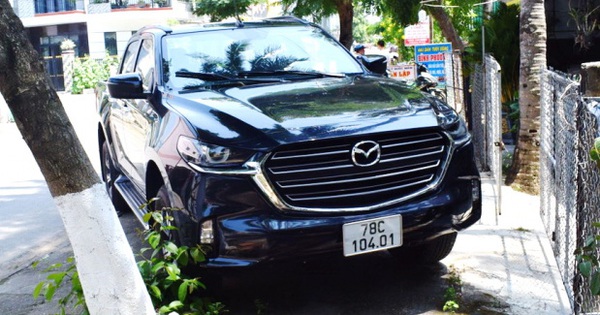Quang BinhFor the past 30 years, the Van Kieu tribe in Doong village has lived in isolation in the national forest, lacking electricity, telephone lines, health services, and roads.
Ban Doong belongs to the commune of Tan Trach, Bo Trach district, but is located in the highly protected core zone of Phong Nha – Ke Bang National Park, in the middle of a valley of about 10 hectares, surrounded by primeval forest and limestone mountains. . If you want to enter Doong village, it takes more than an hour for people who are used to walking to come because 3 km of narrow forest roads, lots of shrubs.
Thirty years ago, Mr. Nguyen Soai Trac, then 41 years old, and several loggers from Truong Son commune, Quang Ninh district, came here to look for honey. Seeing the vast Doong valley and fertile land, he invited his wife and children to distribute trees and establish a village. From there, Ban Doong was born, an initial population of about 20, with four households.
The forest is deep and poisonous, the trees are thick, there are many wild animals. Ho Thi Vai’s mother (now 66 years old, Pak Trac’s wife) said that when she went to cast fishing nets, “I saw tiger footprints like cat’s paws, but as big as a bowl of rice”. Many times when he went into the dense forest to pick bamboo shoots, he saw wild beasts break the tops of rattan trees, and scrape the bark. “The most common are wild boars, many of them have long fangs which are very dangerous and should be kept away,” said Mrs. Vai.
In the village, there is a river flowing in the Truong Son forest, Pak Trac and his wife use their hands to break the land into fields and plant wet rice. There are two rice harvests a year, without ash fertilizer, but the climate is favorable, so the family has enough rice for the whole family to eat all year round. The diet is based on river fish and wild vegetables. However, in 2004-2005, the water source was depleted for unknown reasons. Doong villagers have to leave their rice fields, and the forest situation can’t actively eat rice. Many households moved to other places.
Currently, Doong Village has 13 families (12 poor families) with a total of 52 people, of which 1 family has migrated from outside, the rest are the children and grandchildren of Pak Trac and Vai. Life in the village is almost self-sufficient, lacking many things such as electricity, telephone lines, medical stations, motor roads …

Ban Doong is located in the core zone of Phong Nha – Ke Bang National Park, surrounded by primeval forest and limestone mountains. Photo: Hoang Apple
In 2016, Doong village formed the first Party cell, led by Mr. Nguyen Van Choc, 31 years old, as Secretary. Pak Choc said that around the village there is a lot of flat land but cannot cultivate rice fields due to lack of water. When planting upland rice, “new land must be planted, but the old land does not grow”. Corn, potatoes, cassava … villagers also cultivate moderate land because “planting too much can’t eat all, don’t sell a lot of money”.
According to the Secretary of the Party cell, in 13 households, 12 houses have buffalo and cows, the total herd is about 55 heads. Here, one household buys the breed, another takes care of the cattle, and when buffalo and cows breed, they are divided among themselves. Sometimes, traders from the delta come to the village to see and negotiate prices, then people bring buffalo to Ho Chi Minh Street to sell. From the village up, it takes about three and a half hours for the buffalo and cows to go, the price is about three million dong less.
When they have money, people go out of the village to buy cooking oil, salt and other necessities. Ho Thi Thu, 30, Pak Choc’s wife, said that she only goes to the market once a month, whenever she runs out. a million dong, but “only leave when Choc has a salary”.
The first “midwife” in the village was Mrs. Ho Thi Vai, who has since passed it on to his daughter-in-law, Ho Thi Thu. The whole village has 26 children, 24 children were born in the village. As for Bu Thu, in her 12 years of being a bride, she gave birth to 10 children. He did not receive training for a day, only through his mother-in-law’s instructions.
In 2021, Thu and several sisters helped a woman in the village of “round mother and square child” after two days and two nights of giving birth. Babies are born using strings pulled from rice sacks to tie their umbilical cords before they are cut with bamboo sticks. “There is no medicine here, the mother only drinks the leaves and roots. After three days of giving birth, she stopped abstinence and lived alone,” said Thu.

Pak Nguyen Soai Trac, Head of Doong Village, now 73 years old, wanted to have an irrigation pipe to cultivate his rice fields and took the initiative to eat rice. Photo: Hoang Apple
The village has a school, established in 2010. Teachers in the village depend on the community and suffer from many shortcomings. Without a phone signal, the teachers are isolated, oblivious to the outside world. Whenever the commune of Tan Trach has an official shipment, it takes 4-5 days to arrive. Communities and schools often use rangers or travel agents to send documents, when needed, new people will be notified.
The area has many valuable animals such as chamois, wild boar, monkey, langur douc, hornbill, valuable wood like doi, tuu… so starting 2019, Phong Nha – Department of Forest Protection Ke Bang National Park set up a village camp with two guards living in the village of Doong. The village also has two forest conservation and protection groups with 10 members, which regularly patrol and prevent acts of vandalism.
Nguyen Van Choc and his nephew Nguyen Van Sinh were accepted as rangers at the Department of Forest Protection in Phong Nha National Park – Ke Bang. Integration with the outside world also begins to open, when four students return to Dong Hoi City to attend high school.
For nearly ten years, Doong village has also been a stop for tours to explore Son Doong and En caves. Many tourists pass through the village, but people do not take advantage of the opportunity to improve their livelihoods. One household used to make rattan oi (fish baskets) and sell them to guests as souvenirs for 300,000 VND each, but that didn’t last long.

Without electricity, Ho Thi Thu used to cook while it was still early. Photo: Hoang Apple
Despite living in poverty, the villagers don’t want to leave because of the habit of living independently, “don’t know how to make money”. “We only hope that the government will support a 3 km water pipeline network to the village to cultivate rice fields, take the initiative to eat, and want a telephone signal to communicate with outsiders,” said village head Nguyen Soai Trac.
Deputy Permanent Secretary of the Tan Trach Commune, Mr. Tran Huong Lam, said that the people of Doong village accepted the general policy of the state for minorities, and the policies of Phong Nha – Ke Bang National Park for people in the core area. . The commune is studying irrigation for people to grow wet rice, and has proposed to its superiors to extract capital or called for socialization.
The Bo Trach District also has a policy of relocating people from the core area of the national park, but the residents of Doong village disagree. And making the way to the village is “nearly impossible” as this is a highly protected national forest area.
at Blogtuan.info – Source: vnexpress.net – Read the original article here



